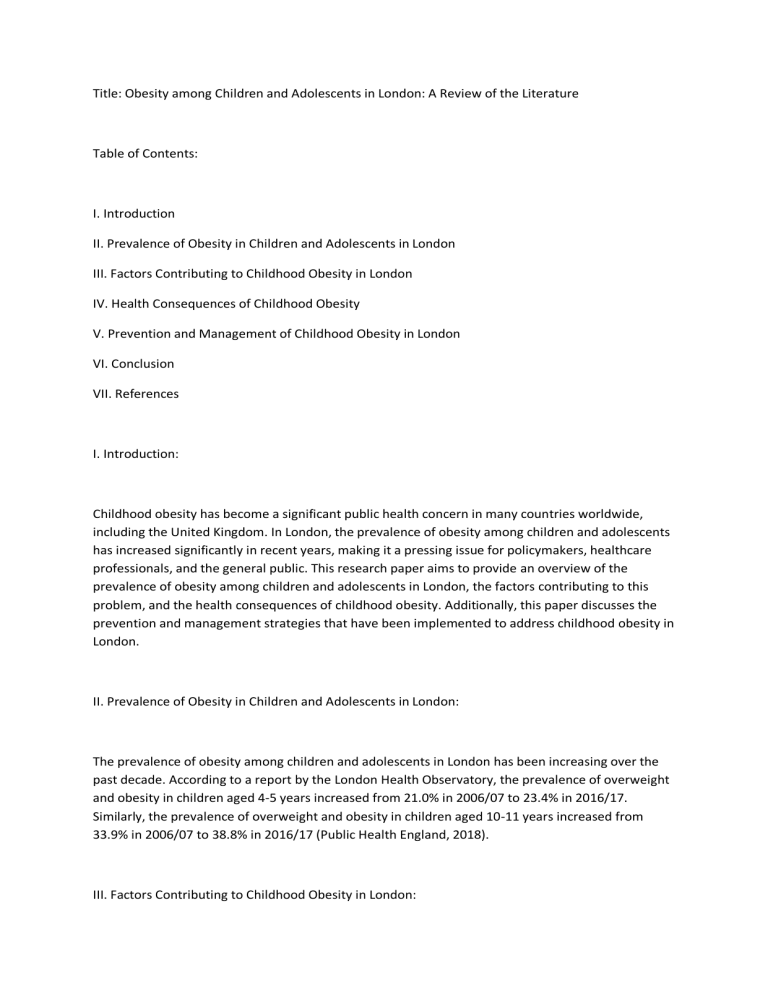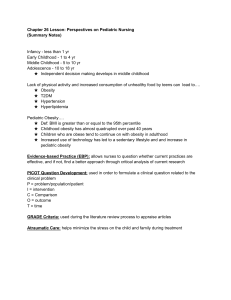
Title: Obesity among Children and Adolescents in London: A Review of the Literature Table of Contents: I. Introduction II. Prevalence of Obesity in Children and Adolescents in London III. Factors Contributing to Childhood Obesity in London IV. Health Consequences of Childhood Obesity V. Prevention and Management of Childhood Obesity in London VI. Conclusion VII. References I. Introduction: Childhood obesity has become a significant public health concern in many countries worldwide, including the United Kingdom. In London, the prevalence of obesity among children and adolescents has increased significantly in recent years, making it a pressing issue for policymakers, healthcare professionals, and the general public. This research paper aims to provide an overview of the prevalence of obesity among children and adolescents in London, the factors contributing to this problem, and the health consequences of childhood obesity. Additionally, this paper discusses the prevention and management strategies that have been implemented to address childhood obesity in London. II. Prevalence of Obesity in Children and Adolescents in London: The prevalence of obesity among children and adolescents in London has been increasing over the past decade. According to a report by the London Health Observatory, the prevalence of overweight and obesity in children aged 4-5 years increased from 21.0% in 2006/07 to 23.4% in 2016/17. Similarly, the prevalence of overweight and obesity in children aged 10-11 years increased from 33.9% in 2006/07 to 38.8% in 2016/17 (Public Health England, 2018). III. Factors Contributing to Childhood Obesity in London: Several factors have been identified as contributing to the high prevalence of childhood obesity in London. These include unhealthy diets, lack of physical activity, and socioeconomic factors. Many children in London consume diets that are high in sugar, salt, and fat, which can lead to weight gain. Additionally, many children in London do not engage in enough physical activity, which can contribute to obesity. Finally, socioeconomic factors such as poverty and social deprivation can also contribute to obesity by limiting access to healthy foods and opportunities for physical activity. IV. Health Consequences of Childhood Obesity: Childhood obesity can have serious health consequences, both in the short term and the long term. In the short term, obesity can lead to a range of health problems, including type 2 diabetes, high blood pressure, and sleep apnea. In the long term, obesity can increase the risk of developing a range of chronic diseases, including heart disease, stroke, and certain types of cancer. Additionally, childhood obesity can have significant psychological consequences, including low self-esteem and depression. V. Prevention and Management of Childhood Obesity in London: Several strategies have been implemented to prevent and manage childhood obesity in London. These include promoting healthy eating and physical activity in schools and communities, increasing access to healthy foods, and providing support for families to make healthy lifestyle choices. Additionally, healthcare professionals play a crucial role in the prevention and management of childhood obesity by providing screening and counseling services for children and families. VI. Conclusion: Childhood obesity is a significant public health concern in London, with high prevalence rates and serious health consequences. The factors contributing to childhood obesity in London are complex, and addressing this problem requires a multifaceted approach that involves policymakers, healthcare professionals, and the general public. Strategies aimed at promoting healthy eating and physical activity, increasing access to healthy foods, and providing support for families can help prevent and manage childhood obesity in London. VII. References: 1. Public Health England. (2018). National Child Measurement Program: England, 2016/17 school year. Retrieved from https://digital.nhs.uk/data-and-information/publications/statistical/nationalchild-measurement-program

